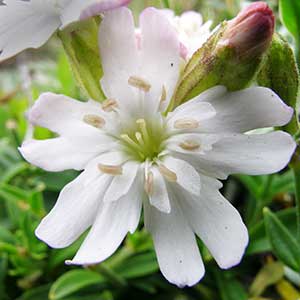Silene douglasii var. oraria
Silene douglasii
Cascade head catchfly, seabluff catchfly
Douglas' campion, Douglas' catchfly, Douglas' silene, mountain navarretia, seabluff catchfly
several–many, ascending from decumbent base, usually unbranched, slender, 10–40(–70) cm, with short, fine, dense, retrorse or curled grayish white hairs, rarely subglabrous, typically not glandular but occasionally somewhat glandular distally.
blades oblanceolate, 2–5(–8) cm × 3–13 mm × 0.3–0.7 mm, fleshy.
2 per node, finely retrorse;
blade with no visible lateral veins, midrib distinct, oblanceolate, elliptic to linear, 2–10 cm × 1.5–13 mm, apex acute, puberulent to glabrous;
basal leaves numerous, blade spatulate;
cauline in 1–8 pairs, distal ones sessile.
eglandular.
typically cymose, occasionally with reduced lateral cymes, 1- or 3-flowered, open, bracteate, grayish white retrorse-puberulent, typically not glandular, rarely with few stipitate glands;
bracts narrowly lanceolate, 2–10 × 0.5–2 mm, herbaceous, puberulent.
ascending, straight, 0.5–4 cm.
calyx strongly suffused with purple, strongly inflated, (4–) 7–10(–12) mm diam. at anthesis, eglandular;
petal limb 5–11 mm wide, often with lateral tooth on each side.
calyx green, sometimes suffused with purple, prominently 10-veined, tubular in flower, campanulate and ± inflated in fruit, occasionally somewhat constricted near base, 12–15 × 3–10 mm, papery, grayish white retrorse-puberulent and eglandular, often ciliate, rarely glabrous or with few stipitate glands, veins parallel, green, forked and connate between lobes, lobes 5, erect, ovate-triangular, 2–3 mm, margins membranous, apex blunt;
corolla creamy white, often greenish and occasionally tinged with dark pink, clawed, to 2 times calyx, claw slightly longer than calyx, limb obovate-lanceolate, deeply 2-lobed, 4–11 mm, lobes oblong, rounded, margins entire to erose, appendages 1–2(–3) mm;
stamens equaling corolla claw;
styles 3–5, 1–11/2 times corolla claw.
ovoid-ellipsoid, 11/3 times calyx, opening by 3–5 ascending to spreading teeth;
carpophore 3–4 mm.
rusty brown, broadly reniform, sides flat, 1.2–1.5 mm, margins coarsely papillate, verrucate-tuberculate.
Silene douglasii var. oraria
Silene douglasii
Variety oraria is in the Center for Plant Conservation’s National Collection of Endangered Plants.
(Discussion copyrighted by Flora of North America; reprinted with permission.)
Varieties 3 (3 in the flora).
Silene douglasii is usually readily recognized by its characteristic short, retrorse, grayish-white, eglandular pubescence on the calyx and pedicels. This, together with the usual absence of lateral teeth on the petals, appears to be the only reliable character separating it from S. parryi. However, intermediates between the two species occur, and it is probable that the occasional plants of S. douglasii with stipitate-glandular hairs in the inflorescence (e.g., var. rupinae and some plants that have been referred to var. monantha) have arisen through gene exchange with S. parryi, although it should be noted that A. R. Kruckeberg (1961) reported that such hybrids, when artificially produced, were sterile.
(Discussion copyrighted by Flora of North America; reprinted with permission.)
1. Leaf blades 3-13 mm wide, 0.3-0.7 mm thick, fleshy; calyces strongly inflated, (4-)7-10(-12) mm diam. at anthesis; petal limbs 5-11 mm wide, often with lateral tooth on each side; coastal Oregon | var. oraria |
1. Leaf blades 1.5-9 mm wide, 0.1-0.5 mm thick, not fleshy; calyces not strongly inflated, (3-)5-8(-10) mm diam. at anthesis; petal limbs 1-5 mm wide, usually without lateral teeth; widespread in w North America | → 2 |
2. Leaf blades 1.5-5 mm wide, typically over 15 times longer than wide, ± linear; pubescence on inflorecences and calyces often glandular; cliffs and ledges of Columbia River gorge | Silene douglasii var. rupinae |
2. Leaf blades 2-9 mm wide, typically 5-10 times longer than wide, oblanceolate to elliptic to broadly linear; pubescence on inflorescences and calyces eglandular (very rarely with few stipitate glands); widespread in w North America | var. douglasii |


